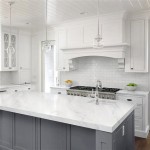Kitchen Lighting Design Rules Of Thumb
The kitchen is one of the most important rooms in any home. It serves as a place to prepare and cook food, gather with family and friends, and even entertain guests. For all of these activities, proper lighting is essential.
There are a few general rules of thumb that can help you achieve good lighting in your kitchen. First, you'll want to use a combination of general, task, and accent lighting.
General Lighting
General lighting is the overall ambient light that illuminates the entire kitchen. It can come from a variety of sources, such as recessed lighting, pendant lights, or chandeliers.
When choosing general lighting, it's important to consider the size of your kitchen as well as the overall style of the room. For a small kitchen, a single pendant light or chandelier may be sufficient. For a larger kitchen, you may need to use a combination of recessed lighting and pendant lights.
Task Lighting
Task lighting is used to illuminate specific areas of the kitchen, such as the countertop, sink, or stovetop. It can come from a variety of sources, such as under-cabinet lighting, pendant lights, or track lighting.
When choosing task lighting, it's important to consider the type of task that will be performed under the light. For example, if you'll be using the task lighting for cooking, you'll want to choose a light that is bright and focused. If you'll be using the task lighting for reading, you'll want to choose a light that is softer and more diffused.
Accent Lighting
Accent lighting is used to highlight specific features of the kitchen, such as a backsplash, a piece of artwork, or a kitchen island. It can come from a variety of sources, such as recessed lighting, track lighting, or sconces.
When choosing accent lighting, it's important to consider the overall style of the kitchen and the effect you want to create. For example, if you want to create a dramatic effect, you can use accent lighting to highlight a piece of artwork. If you want to create a more subtle effect, you can use accent lighting to highlight the backsplash or a kitchen island.
Other Considerations
In addition to the three main types of lighting, there are a few other considerations to keep in mind when designing your kitchen lighting.
First, consider the color of the light you want to use. The color of the light can have a significant impact on the overall mood of the kitchen. For example, a warm light can create a cozy and inviting atmosphere, while a cool light can create a more sterile and modern atmosphere.
Another consideration is the amount of natural light that your kitchen receives. If your kitchen has a lot of natural light, you may not need to use as much artificial light. However, if your kitchen is dark, you may need to use a combination of artificial and natural light to achieve the desired level of brightness.
Finally, consider the overall style of your kitchen. The type of lighting you choose should complement the overall style of the room. For example, if you have a traditional kitchen, you may want to choose traditional lighting fixtures. If you have a modern kitchen, you may want to choose modern lighting fixtures.
By following these general rules of thumb, you can achieve good lighting in your kitchen that will make the space more functional, inviting, and stylish.

58 Gorgeous 21 Kitchen Design Rules Most Outstanding In 2024

The How To Lighting Guide Lightology

Rule Of Thumb For Recessed Light Placement

Essential Guide To Pendant Lighting Sizing Spacing More

Jim Lawrence Kitchen Pendant Guide

5 Kitchen Lighting Design Tips For A Beautiful

How To Choose Kitchen Island Pendant Lighting 1stoplighting

Kitchen Lighting Guide Inspiration

How To Plan Lighting For Your Kitchen

The How To Lighting Guide Lightology
See Also








